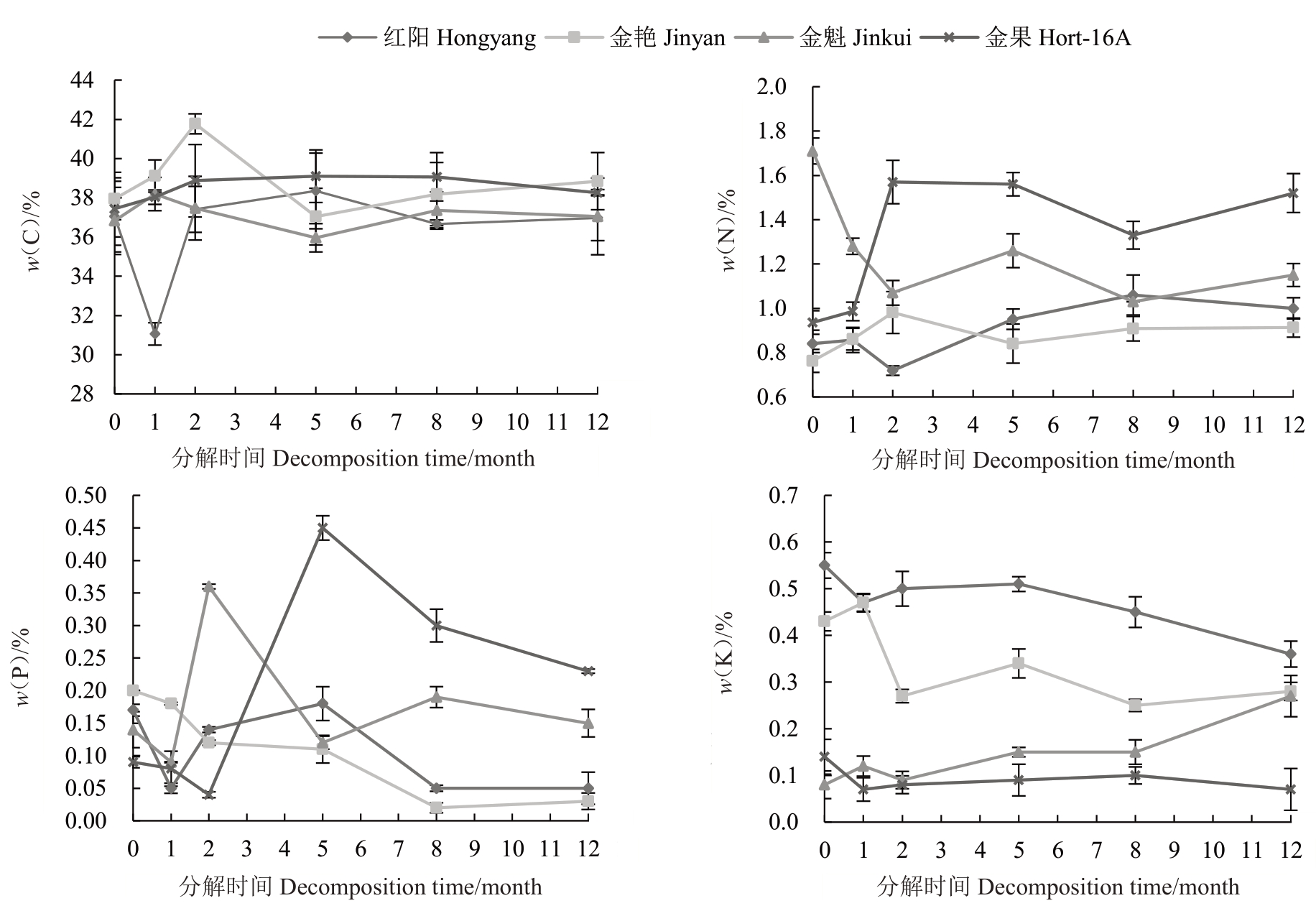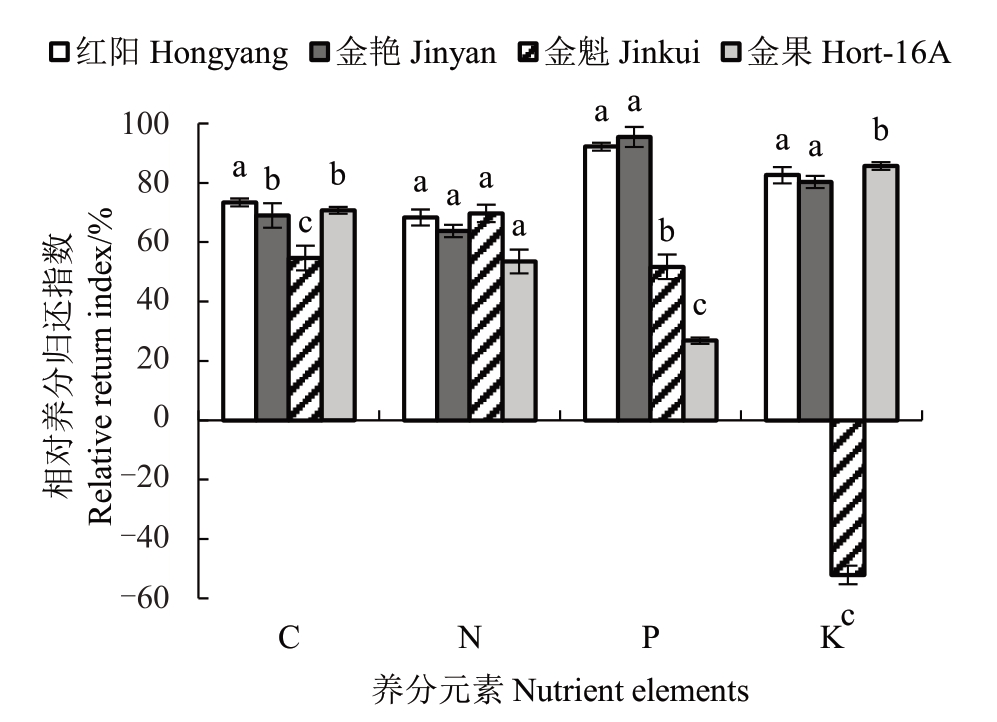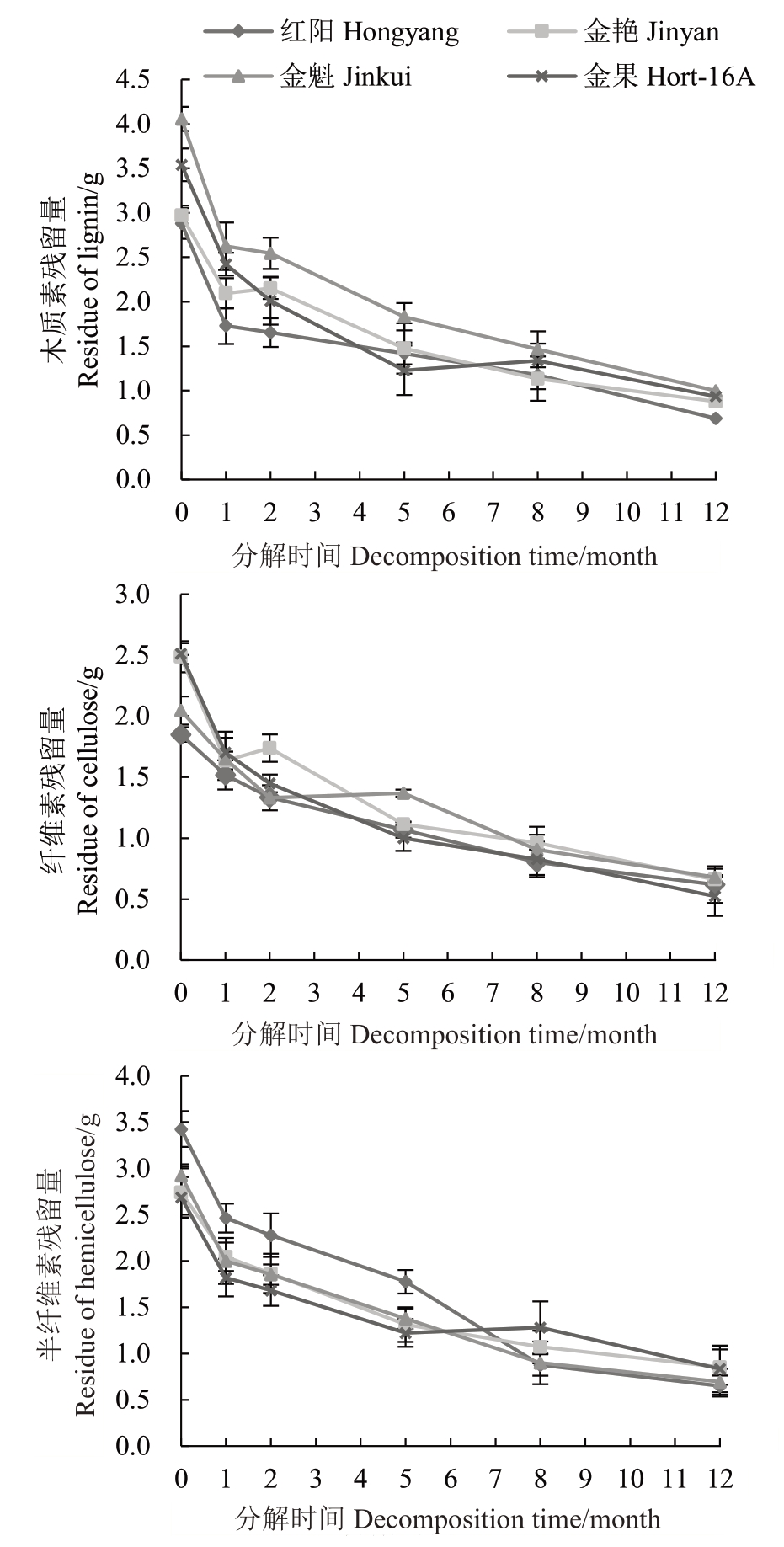猕猴桃(Actinidia)是一种原产中国的特色水果,它风味独特,富含维生素C、膳食纤维等营养物质,有“水果之王”之称。目前中国的猕猴桃种植面积和产量均为世界第一,是名副其实的猕猴桃生产大国。截至2019 年底,中国猕猴桃种植面积达29.1万hm2,总产量达300万t,种植区域包括了21个省份[1]。在果园中,冬季修剪是一种常见的管理手段,可以提高果实产量和品质,抑制果树营养生长[2]。猕猴桃作为一种落叶果树,冬季落叶后修剪可以选留优良母枝,改善树体结构,是一种保障果园丰产稳产的管理措施。
研究发现,中国每666.7 m2果园每年的枝条修剪量可达0.5 t[3],而修剪枝条的处理不当,比如焚烧、乱堆乱放等,会造成环境污染和病虫害传播[4]。因此,将枝条还田分解不仅可以避免环境污染等问题,还可以补充土壤中的N、P、K等养分元素,减少肥料的使用,进而提升果园经济效益[5-7]。果树枝条还田分解过程与凋落物分解原理相一致,研究表明,凋落物基质质量,比如C、N、P 等养分含量以及木质素、多酚等顽拗物质的含量,是影响凋落物分解速率和养分释放的主要因素[8-10]。一般认为,N 含量较高、木质素含量较少的凋落物,基质质量较好,分解速率较快[11-12]。而对于枝条,与凋落叶相比,具有较低的养分(N、P 等)含量和较高的顽拗物(木质素等)含量,因而可能具备一些独特的分解特征[13-14]。此外,一个果园内往往种植了多个果树品种,而不同品种之间凋落物的基质质量可能存在差异,进而导致分解特征的差异。而目前关于果树修剪枝条的分解过程及养分释放动态的研究较少,且关于枝条基质质量对分解速率的影响机制尚不清楚。
在猕猴桃果园中,冬季修剪是一种常见的管理手段,而修剪枝条的还田分解过程及养分释放动态尚未见相关报道。研究发现,猕猴桃果树每产出100 kg果实,需要消耗540 g N、82 g P 和418 g K[15],因此,猕猴桃果园需要大量的养分投入,而枝条还田分解释放的养分对土壤肥力的补充作用尚未通过定量分析试验验证。此外,枝条与其他凋落物相比,具有较高的木质素含量,而基质质量不同可能导致分解过程的差异。笔者在本研究中以4个品种的猕猴桃果树(红阳、金艳、金魁、金果)修剪枝条为研究对象,分析了分解速率,养分释放动态,木质素、纤维素和半纤维素分解过程,以及基质质量与分解速率的相关性。研究旨在指导果园科学施肥,减少管理成本,提高经济效益,同时揭示高木质素基质对凋落物分解过程的影响机制。
1 材料和方法
1.1 供试材料
试验地为江西省科学院猕猴桃产业基地(115°19′02″ E, 28°40′36″ N),占地约13.3 hm2,位于江西省奉新县,属亚热带季风气候,年平均温度17.6 ℃,降水量1 671.5 mm。年平均相对湿度79%,无霜期260 d,日照时长1 784.9 h,土壤类型为红壤性土。奉新县野生猕猴桃资源丰富且有近50 a(年)的猕猴桃栽培史,有“中华猕猴桃之乡”之称。目前全县猕猴桃种植约5300 hm2,总产量约55 000 t。以奉新县主栽品种红阳、金艳、金魁和金果猕猴桃的修剪枝条作为试验材料。其中,红阳猕猴桃是由中华猕猴桃(A.chinensis)实生植株发现芽变后选育而成,种子周边果肉呈鲜红色,是红肉猕猴桃的代表品种之一[16]。金艳猕猴桃是以毛花猕猴桃(A.eriantha)为母本、中华猕猴桃为父本杂交后选育的品种,是黄肉猕猴桃的代表品种之一[17]。金魁是由野生美味猕猴桃(A.deliciosa)实生苗驯化选育而来,是绿肉猕猴桃的代表品种之一[18]。金果猕猴桃,别称黄金果,原名Hort-16A,是由新西兰培育的中华猕猴桃品种,也是黄肉猕猴桃的代表品种之一[19]。
1.2 试验设计
采用分解袋法,在江西省科学院猕猴桃产业基地进行猕猴桃修剪树枝条原位分解试验。于每个品种种植区设置3个5 m×5 m的样方。2020年12月,果树修剪完成后,在每个样方收集果树枝条,除去表面泥土等杂物后,将枝条剪为15~20 cm 的小段,60 ℃烘干至恒质量。称取15 g枝条样品,装入规格为长宽15 cm×25 cm、网眼0.5 mm 的尼龙分解袋中。同时,保留部分样品用于测定初始基质质量。2021 年1 月初,将分解袋平铺在每个样方土层表面,并用钉子固定。每个样方设置5 个分解袋,每个果树品种共15 个分解袋,共计60 个分解袋。根据凋落物分解速率先快后慢的基本属性,在每个样方内,分别于分解试验的第1、2、5、8、12 个月回收1次分解袋,分解试验总时间为12 个月,试验期间月平均气温见图1。

图1 分解试验期月平均气温(2021 年)
Fig.1 Mean temperature during decomposition experiment in 2021
1.3 样品测定
回收分解袋后,取出枝条样品,除去泥土、根系等杂物,60 ℃烘干至恒质量后称取残留物质量。同时分析残留物中养分含量,全C 和全N 含量采用元素分析仪测定,全P含量采用紫外分光光度计测定,全K 含量采用火焰光度计测定[20-21]。木质素和纤维素含量采用重铬酸钾-硫酸亚铁铵滴定法测定,半纤维素含量采用铜碘法测定[22-23]。
1.4 数据分析
基于猕猴桃果树枝条分解后的残留量(转化为残留率)和分解时间,采用Olson分解模型拟合分解曲线,计算分解速率[13,24]。模型公式如下:
式中,y为残留率,t为分解时间,a、b为模型常数。模型拟合采用SigmaPlot 12.5软件进行,并计算分解半衰期(T0.5,即干物质分解50%所需的时间)和周转期(T0.05,即干物质分解95%所需的时间)。
养分元素和木质素等成分的残留量计算公式为:Rt=Mt×Ct。式中,Rt为分解t 时间的元素(或其他成分)残留量,Mt为分解t 时间的枝条干物质质量,Ct为分解t 时间的元素(或其他成分)的百分比含量。
采用相对养分归还指数衡量养分释放比例,计算公式为[25]:
式中,RRI为相对养分归还指数,M0为枝条干物质初始质量,C0为养分元素的初始百分比含量,当t=12时,即为分解试验结束时果树枝条的养分归还指数(即养分释放比例)。
木质素等成分的降解率(%·月-1)计算公式为[26]:
式中,Dt为降解率,Lt-1和Lt分别为分解t-1 和t时间的残留量,L0为初始残留量,△T为分解时间的长度。
采用SPSS 26 软件,对4 种果树枝条的基质质量指标、相对养分归还指数、木质素降解率等数据进行单因素方差分析(ANOVA),以检验不同果树之间数据的差异显著性,多重比较采用最小显著差异法(LSD)(p<0.05),同时对果树枝条基质质量指标与分解速率(半衰期和周转期)进行相关性分析,相关系数为皮尔逊相关系数(Pearson Correlation Coefficient)。绘图采用SigmaPlot 12.5 和Excle软件。
2 结果与分析
2.1 猕猴桃果树枝条分解速率及其与基质质量的相关性
4 个猕猴桃品种的修剪枝条中,分解速率由快至慢依次为红阳、金果、金艳、金魁(图2)。猕猴桃枝条分解半衰期分别为5.2 个月、6.2 个月、6.4 个月和7.2个月,周转期分别为26.6个月、26.7个月、29.7个月和31.1个月。

图2 猕猴桃修剪枝条分解速率
Fig.2 Decomposition rate of pruned branches of kiwifruit trees
对比4 个猕猴桃品种枝条基质质量,红阳猕猴桃K和半纤维素含量较高,木质素、纤维素含量较低(表1)。金艳猕猴桃P 和纤维素含量较高。金魁猕猴桃N和木质素含量较高。金果猕猴桃纤维素含量较高,P和半纤维素含量较低。
表1 猕猴桃修剪枝条基质质量
Table 1 Chemical character quality of pruned branches of kiwifruit trees

注:表内数据为(平均值±标准偏差);同一行不同小写字母表示存在显著差异,p<0.05。
Note:The values in table are(Mean±SD);different lowercase letters in the same line indicate significant differences,p<0.05.
基质Substrate w(C)/%w(N)/%w(P)/%w(K)/%C/N C/P N/P w(木质素)Lignin content/%w(纤维素)Cellulose content/%w(半纤维素)Hemicellulose content/%木质素/N Lignin/N金果Hort-16A 37.44±0.12 b 0.94±0.08 b 0.09±0.03 d 0.14±0.04 c 40.00±6.42 b 416.00±60.87 a 10.40±4.86 b 23.60±1.65 b 16.75±1.42 a 17.92±1.75 d 25.21±4.10 a红阳Hongyang 37.04±0.15 c 0.84±0.08 b 0.17±0.02 b 0.55±0.08 a 44.04±4.05 a 217.88±25.97 c 4.95±1.28 c 19.20±1.45 d 12.33±1.57 c 22.84±2.14 a 22.83±3.21 b金艳Jinyan 37.95±0.23 a 0.76±0.05 b 0.20±0.03 a 0.43±0.05 b 49.74±4.92 a 189.75±30.15 d 3.82±0.91 c 19.79±1.94 c 16.58±1.58 a 18.29±1.82 c 25.94±4.35 a金魁Jinkui 36.82±0.10 c 1.71±0.06 a 0.14±0.02 c 0.08±0.02 d 21.53±0.82 c 263.00±43.5 b 12.21±2.53 a 27.04±2.04 a 13.64±1.27 b 19.49±2.30 b 15.81±1.70 c
猕猴桃枝条基质质量与分解速率存在相关性,其中,N和木质素含量与分解半衰期呈正相关,K和半纤维素含量与分解半衰期呈负相关(表2)。此外,C含量与N含量呈负相关,与纤维素含量呈正相关。N 含量与K 含量呈负相关,与木质素含量呈正相关。P 含量与K 含量呈正相关,与木质素含量呈负相关。K 含量与木质素含量呈负相关,与半纤维素含量呈正相关。纤维素含量与半纤维素含量呈负相关。
表2 猕猴桃枝条基质质量与分解速率的相关性
Table 2 Correlation between substrate quality and decomposition rate of kiwifruit branches

注:T0.5.半衰期,即干物质分解50%所需的时间;T0.05.周转期,即干物质分解95%所需的时间;*.p<0.05;**.p<0.01。
Note:T0.5.The half-life,which is the time it takes for a dry matter to decompose by 50%;T0.05.The turnover period,which is the time it takes for a dry matter to decompose by 95%;*.p<0.05;**.p<0.01.
基质Substrate C N P K 木质素Lignin纤维素Cellulose半纤维素Hemicellulose T0.5 NPK木质素Lignin纤维素Cellulose半纤维素Hemicellulose T0.5-0.715**0.240 0.344-0.527 0.763**-0.529-0.099-0.068-0.287-0.716**0.884**-0.329-0.053 0.748**0.651*0.762**-0.639*-0.280 0.399-0.270 0.265-0.945**-0.277 0.590*-0.781**-0.367 0.013-0.383 0.825**0.514-0.917**0.294 0.023-0.636*-0.324 0.845**T0.05
2.2 猕猴桃枝条分解过程中养分释放(富集)动态
4 个猕猴桃品种枝条C 元素初始含量较为接近,均在36%~38%之间,在分解过程中,C元素为相对稳定状态,基本在36%~40%范围内浮动,表明C元素随着干物质的分解而逐步释放(图3)。金魁猕猴桃枝条N 元素初始含量较高,为1.71%,随着干物质的分解,N 含量逐渐下降,表现为元素的释放。红阳、金艳和金果猕猴桃枝条N元素初始含量较低,为0.7%~0.9%,随着干物质的分解,N 含量逐渐上升,表现为元素的富集。4 个猕猴桃品种枝条P 元素初始含量较为接近,为0.09%~0.2%,随着干物质的分解,P 元素含量呈现“下降—上升”的波动变化,表明P 元素为“释放-富集”的连续过程。红阳和金艳猕猴桃枝条K 元素初始含量较高,为0.4%~0.55%,随着干物质的分解,K 元素逐渐下降,表现为逐渐释放。金魁和金果猕猴桃枝条K 元素初始含量较低,为0.08%~0.14%。随着干物质的分解,金魁猕猴桃枝条K 元素逐渐上升,表现为元素的富集。而金果猕猴桃枝条K 元素含量在分解试验第1 个月后下降,之后保持相对稳定,在0.07%~0.1%范围内浮动。

图3 猕猴桃枝条分解过程中养分含量的变化
Fig.3 Dynamics of nutrient content in branches of kiwifruit during decomposition
经过12 个月的分解试验,红阳和金艳猕猴桃枝条的相对养分归还指数较高,C 为69%以上,N为63%以上,P 为92%以上,K 为80%以上(图4)。金果猕猴桃枝条C 和K 的归还指数较高,分别为70%和85%,而N 和P 较低,分别为53%和26%。金魁猕猴桃枝条N 的归还指数较高,为69%,而C 和P 较低,分别为54%和51%,K 则为-52%,为富集状态。

图4 猕猴桃枝条分解相对养分归还指数
Fig.4 Relative return index of kiwifruit branches during decomposition
2.3 猕猴桃枝条木质素、纤维素和半纤维素降解特征
猕猴桃枝条分解过程中,木质素、纤维素和半纤维素的残留量均为逐步下降趋势,表明木质素、纤维素和半纤维素随干物质的分解而逐步降解(图5)。其中,红阳猕猴桃枝条木质素降解最快,其次是金果和金艳,金魁最慢,与干物质的分解速率相一致。4个猕猴桃品种枝条的纤维素降解速率较为接近。在分解试验前5 个月,金魁猕猴桃枝条半纤维素降解最快,其次是金果和金艳,红阳最慢,与干物质分解速率不一致。而在分解试验的5—12 月,红阳和金艳猕猴桃枝条半纤维素降解较快,而金魁和金果降解较慢。

图5 猕猴桃枝条分解过程中木质素、纤维素和半纤维素残留量变化
Fig.5 Dynamics of lignin,cellulose,and hemicellulose residues of kiwifruit branches during decomposition
4 个猕猴桃品种枝条的木质素、纤维素和半纤维素的月平均降解率均在分解试验的第1 个月最高,之后下降(图6)。其中,分解试验的1 月木质素降解率为30%~40%,之后均在10%以下。此外,金艳猕猴桃枝条在2月、金果猕猴桃在7—9月出现了负降解,即累积现象。金艳和金果猕猴桃枝条在1月纤维素降解率较高,为30%以上,而红阳和金魁猕猴桃枝条为18%~19%。在2月、3—9月、10—12月,猕猴桃枝条纤维素降解率呈现10%、5%、3%的下降趋势。金艳猕猴桃枝条纤维素在2 月、金魁猕猴桃在3—5月出现累积现象。4个猕猴桃品种枝条在分解试验的1月半纤维素降解率为25%~32%,2—9月降解率约为5%,10—12 月约为2%。金果猕猴桃枝条半纤维素在7—9月出现了累积现象。

图6 猕猴桃修剪枝条木质素、纤维素和半纤维素降解率
Fig.6 Degradation rates of lignin,cellulose,and hemicellulose in pruned branches of kiwifruit trees
3 讨 论
3.1 猕猴桃枝条基质质量对分解速率的影响
同一气候条件下,凋落物基质质量是影响其分解速率的主要因素[8,27]。凋落物干物质的生物降解过程,主要由土壤动物、微生物等分解者完成。而凋落物中的N、P 等养分含量是保障分解者完成生理活动的营养基础,因此,一般认为,N、P 等养分含量较高,凋落物基质质量越好,其分解速率较快[27]。另一方面,木质素、纤维素和多酚类物质是凋落物中的顽拗物质,一般不能被微生物直接降解,需要借助某些酶的作用[26]。因此,一般认为,木质素含量越高,凋落物分解速率越慢[11,25]。本研究中,红阳猕猴桃枝条木质素、纤维素含量较低,分解速率最快,而金魁猕猴桃N 和木质素含量较高,分解速率最慢。N和木质素含量与分解半衰期呈正相关,K 和半纤维素含量与分解半衰期呈负相关。对于木质素含量较高的凋落物,即使初始N含量较高,并不能加速凋落物分解,这与Perakis 等[28]的研究相一致。原因是凋落物木质素含量比N含量对凋落物分解速率的限制作用更大[11],且高N 含量对木质素分解有抑制作用。其中的作用机制为:(1)高N含量往往会抑制木质素降解酶[29];(2)N可以与木质素分解的副产物发生化学反应而形成稳定的复合化合物,减缓了不稳定C化合物的分解[28];(3)高N环境下生长缓慢的真菌无法与快速生长的微生物竞争,因而许多能够分解木质素的微生物(如担子菌)的生长势会减弱[27,30]。
3.2 果树枝条分解养分释放特征
随着凋落物干物质的分解,C、N、P、K等养分元素会释放至土壤、水、大气等环境中。但由于每种元素在凋落物中存在的形式及分解机制不同,元素的释放过程也存在差异。本研究中,猕猴桃枝条的C元素含量稳定,随着干物质的降解而逐渐释放;N、P含量则存在上升和下降的趋势,即在干物质降解过程中存在元素的富集和释放,这与其他凋落物研究相一致[31-32]。N、P 含量的变化与凋落物中初始N、P浓度和分解者活动相关。根据“底物的C、N化学计量学”假说,凋落物的干物质降解依赖于分解者的生理活动,但分解者完成自身生命活动需要充足的N源和P 源,如果凋落物中N、P 含量不能满足分解者自身需求,则分解者会将周围环境(比如土壤)中的N、P 转移至凋落物中,导致元素的富集,反之,则导致元素的释放[33]。金魁猕猴桃枝条初始N 含量最高,为1.71%,可以为分解者提供充足的N 源,因而表现为元素的释放。而其他3种枝条初始N含量较低,均在1%以下,不能满足分解者生理需求,分解者将土壤中的N元素转移至枝条中,导致N含量上升,表现为元素的释放。4 个猕猴桃品种枝条P 含量均表现为“下降-上升”的波动变化,这是由于P元素除受生物因素影响外,也受淋溶作用影响,分解初期的淋溶作用使P含量下降[34-35]。而之后分解者作用使P含量上升以满足自身生理活动需要,但微生物一旦脱离了P限制,过量的P反而会抑制其活性,进而导致P含量下降,最终表现为P含量的波动变化[36]。
与C、N、P 等结构性元素相比,K 是一种非结构性元素,因而在凋落物分解中主要受淋溶作用影响,一般表现为分解初期迅速释放,之后保持稳定[31,37]。红阳、金艳和金果猕猴桃枝条中的K元素含量均在分解试验内的前1~2 个月迅速下降,之后保持相对稳定。金魁猕猴桃枝条初始K 含量最低,仅有0.08%,随着干物质的分解含量上升,出现了富集现象。在凋落物分解过程中,K 元素的富集现象较为少见,但在福建沙县官庄林场的杉木(Cunninghamia lanceolata)人工林凋落物分解试验中也观察到了这种现象[38]。原因可能是凋落物中K 含量太低,因而与土壤发生了阳离子交换而导致K 含量上升[39],也可能是微生物或非微生物的固定作用使其浓度增加[10,40],具体作用机制还需进一步验证。
3.3 果树枝条木质素、纤维素和半纤维素降解特征
木质素和纤维素是凋落物中的难分解物质,且木质素是限制凋落物分解速率的主要因素之一[25,39]。本研究中,红阳猕猴桃枝条木质素降解最快,其次是金果和金艳,金魁最慢,与干物质的分解速率相一致。木质素限制凋落物分解的机制为:(1)木质素在物理上抵抗胞外酶的降解,即对纤维素和半纤维素有保护作用,从而减缓凋落物质量损失[27,41-42];(2)木质素沉积在半纤维素-蛋白质基质的细胞壁中,可以在物理上保护这些更不稳定的细胞壁成分免受微生物的攻击[43];(3)木质素聚合物可以与半纤维素和蛋白质形成共价键,可能在化学上保护这些不稳定化合物在衰变过程中不被水解[12]。
木质素、纤维素和半纤维素在分解试验的第一个月降解率最高,这与凋落物分解初期可溶性有机C的大量淋溶有关,且随着可溶性C的流失,木质素等物质的降解率在分解中后期呈现下降趋势[26,44]。此外,在分解过程中,木质素等物质的降解率存在负值,即出现了累积现象,这在川西亚高山森林凋落物分解等研究中也被观察到[45]。原因是随着可溶性C、N、P等易分解组分的流失,木质素等难分解组分在凋落物干物质中所占的比例上升[45]。此外,微生物在分解过程中会产生一些难分解的副产物或木质素类似物,可能导致木质素浓度等测量值的上升[46]。
4 结 论
猕猴桃枝条分解50%所需的时间约为6 个月,分解95%所需的时间约为29 个月,4 个品种分解速率由快至慢为红阳、金果、金艳、金魁,凋落物初始N、K、木质素和半纤维素含量均与分解半衰期显著相关。经过12 个月的分解试验,4 个猕猴桃品种枝条释放了50%~70%的C和N,红阳和金艳猕猴桃枝条释放了80%以上的P 和K。因此,猕猴桃果树枝条还田分解是对土壤肥力的重要补充,不同品种之间的枝条分解特征存在差异,基质质量是影响分解速率的主要因素,其中木质素含量对分解速率限制作用最大。
[1] 李岚欣,孙洁,辛奇,赵泽众,刘帮迪,姜微波.乡村振兴背景下我国猕猴桃产业技术高质量发展分析[J].保鲜与加工,2022,22(7):82-90.LI Lanxin,SUN Jie,XIN Qi,ZHAO Zezhong,LIU Bangdi,JIANG Weibo. Analysis and review of high-quality development kiwifruit industry technology under rural revitalization in China[J].Storage and Process,2022,22(7):82-90.
[2] GERMER S,VAN DONGEN R,KERN J.Decomposition of cherry tree prunings and their short-term impact on soil quality[J].Applied Soil Ecology,2017,117:156-164.
[3] 陈炀,王丽霞,杨毅,国一凡,韩梦琪,王军英,邵蕾.山东省果树修剪枝条资源评估及肥料化利用潜力分析[J].中国果树,2020(4):92-95.CHEN Yang,WANG Lixia,YANG Yi,GUO Yifan,HAN Mengqi,WANG Junying,SHAO Lei. Assessment of pruning branch resources of fruit trees and potential analysis of fertilizer utilization in Shandong Province[J].China Fruits,2020(4):92-95.
[4] 郭智勇,靳前龙,韩文君,刘春红,谢利芬.甜瓜秧蔓产量与商品产量相关性分析[J].中国瓜菜,2019,32(8):83-85.GUO Zhiyong,JIN Qianlong,HAN Wenjun,LIU Chunhong,XIE Lifen. Study on the correlation between melons yield and the vines output[J]. China Cucurbits and Vegetables,2019,32(8):83-85.
[5] 杨明昊,张艺灿,王孝娣,史祥宾,王小龙,王海波.果树枝条生物高效分解技术研究进展[J].中国果树,2022(3):10-14.YANG Minghao,ZHANG Yican,WANG Xiaodi,SHI Xiangbin,WANG Xiaolong,WANG Haibo. Advances in efficient decomposition of fruit tree branches by microorganisms[J]. China Fruits,2022(3):10-14.
[6] HAN M Y,ZHANG L X,FAN C H,LIU L H,ZHANG L S,LI B Z,ALVA A K. Release of nitrogen,phosphorus,and potassium during the decomposition of apple (Malus domestica) leaf litter under different fertilization regimes in Loess Plateau,China[J].Soil Science and Plant Nutrition,2011,57(4):549-557.
[7] 屠娟丽,费伟英,张平.秸秆生物炭用量对马铃薯品质及土壤生化性质的影响[J].中国瓜菜,2019,32(12):41-44.TU Juanli,FEI Weiying,ZHANG Ping. Effect of the amount of biochar on potato quality and soil biochemical properties[J].China Cucurbits and Vegetables,2019,32(12):41-44.
[8] GE X G,ZENG L X,XIAO W F,HUANG Z L,GENG X S,TAN B W. Effect of litter substrate quality and soil nutrients on forest litter decomposition:A review[J].Acta Ecologica Sinica,2013,33(2):102-108.
[9] BŁOŃSKA E,PIASZCZYK W,STASZEL K,LASOTA J. Enzymatic activity of soils and soil organic matter stabilization as an effect of components released from the decomposition of litter[J/OL]. Applied Soil Ecology,2021,157:103723. DOI:10.1016/j.apsoil.2020.103723.
[10] NAIK S K,MAURYA S,MUKHERJEE D,SINGH A,BHATT B.Rates of decomposition and nutrient mineralization of leaf litter from different orchards under hot and dry sub-humid climate[J].Archives of Agronomy and Soil Science,2018,64(4):560-573.
[11] RAHMAN M M,TSUKAMOTO J,RAHMAN M M,YONEYAMA A,MOSTAFA K M. Lignin and its effects on litter decomposition in forest ecosystems[J]. Chemistry and Ecology,2013,29(6):540-553.
[12] TALBOT J M,YELLE D J,NOWICK J,TRESEDER K K. Litter decay rates are determined by lignin chemistry[J]. Biogeochemistry,2012,108(1/3):279-295.
[13] 郭彩虹,杨万勤,吴福忠,徐振锋,岳楷,倪祥银,袁吉,杨帆,谭波.川西亚高山森林林窗对凋落枝早期分解的影响[J].植物生态学报,2018,42(1):28-37.GUO Caihong,YANG Wanqin,WU Fuzhong,XU Zhenfeng,YUE Kai,NI Xiangyin,YUAN Ji,YANG Fan,TAN Bo.Effects of forest gap size on initial decomposition of twig litter in the subalpine forest of western Sichuan,China[J]. Chinese Journal of Plant Ecology,2018,42(1):28-37.
[14] SHOROHOVA E,KAPITSA E. The decomposition rate of nonstem components of coarse woody debris(CWD)in European boreal forests mainly depends on site moisture and tree species[J].European Journal of Forest Research,2016,135(3):593-606.
[15] 杨莉莉.不同肥料对猕猴桃产量、品质及果园养分的影响[D].杨凌:西北农林科技大学,2016.YANG Lili. Effect of different fertilizer application on kiwifruit yield,quality and the orchard nutrient[D]. Yangling:Northwest A&F University,2016.
[16] 李文彬.‘红阳’猕猴桃果实发育转录组及花青素累积机理研究[D].武汉:中国科学院武汉植物园,2015.LI Wenbin.Gene expression profiling of development of‘Hongyang’and anthocyanin accumulation in kiwifruit (Actinidia chinensis) based on transcriptome sequencing[D]. Wuhan:Wuhan Botanical Garden,Chinese Academy of Sciences,2015.
[17] 钟彩虹,张鹏,韩飞,李大卫.猕猴桃种间杂交新品种‘金艳’的果实发育特征[J].果树学报,2015,32(6):1152-1160.ZHONG Caihong,ZHANG Peng,HAN Fei,LI Dawei. Studies on characterization of fruit development of interspecific hybrid cultivar‘Jinyan’[J].Journal of Fruit Science,2015,32(6):1152-1160.
[18] 刘科鹏,黄春辉,冷建华,陈葵,严玉平,辜青青,徐小彪.‘金魁’猕猴桃果实品质的主成分分析与综合评价[J].果树学报,2012,29(5):867-871.LIU Kepeng,HANG Chunhui,LENG Jianhua,CHEN Kui,YAN Yuping,GU Qingqing,XU Xiaobiao.Principal component analysis and comprehensive evaluation of the fruit quality of‘Jinkui’kiwifruit[J].Journal of Fruit Science,2012,29(5):867-871.
[19] 李小艳,杨红,刘星谷,蔡光泽.金果猕猴桃在攀西地区的引种表现及关键栽培技术[J].贵州农业科学,2019,47(9):98-101.LI Xiaoyan,YANG Hong,LIU Xinggu,CAI Guangze. Performance and key cultivation techniques of introduced Jinguo kiwifruit in Panxi region[J].Guizhou Agricultural Sciences,2019,47(9):98-101.
[20] 刘易,曹雨虹,张艺帆,谢伟东.南亚热带滨海沙地3 种林分类型凋落物的养分释放动态[J].西北农林科技大学学报(自然科学版),2022,50(8):55-68.LIU Yi,CAO Yuhong,ZHANG Yifan,XIE Weidong. Nutrient release dynamics of litter in three forest types in coastal sandy land of south subtropical region[J]. Journal of Northwest A& F University(National Science Edition),2022,50(8):55-68.
[21] 张頔,满秀玲,刘思琪,徐志鹏.寒温带地区非生长季典型森林群落凋落物分解及养分释放[J].北京林业大学学报,2022,44(3):65-74.ZHANG Di,MAN Xiuling,LIU Siqi,XU Zhipeng. Litter decomposition and nutrient release of typical forest communities in non-growing season in cold temperate zone[J].Journal of Beijing Forestry University,2022,44(3):65-74.
[22] 司徒成,余天华,宋宇欣.不同食用菌对猕猴桃枝木质纤维素降解的比较[J].北方园艺,2022(5):111-118.SI Tucheng,YU Tianhua,SONG Yuxin. Comparison on lignocellulose degradation of kiwifruit branches by different edible fungi[J].Northern Horticulture,2022(5):111-118.
[23] 赵琴,雷涛,张益萍.食品添加剂纤维素含量检测方法的比较研究[J].中国食品添加剂,2022,33(3):212-216.ZHAO Qin,LEI Tao,ZHANG Yiping. Comparative study on the determination of cellulose content in food additive[J]. China Food Additives,2022,33(3):212-216.
[24] OLSON J S.Energy storage and the balance of producers and decomposersinecologicalsystems[J].Ecology,1963,44(2):322-331.
[25] 张广帅,张全军,于秀波,闫吉顺,赵全民,蔡悦荫,宫玮.不同地下水位灰化薹草分解过程中木质素降解与碳、氮、磷释放的关系[J].生态学报,2020,40(9):3006-3015.ZHANG Guangshuai,ZHANG Quanjun,YU Xiubo,YAN Jishun,ZHAO Quanmin,CAI Yueyin,GONG Wei. Correlations between lignin degradation and the C,N,P release during Carex cinerascens decomposition under different ground water level[J].Acta Ecologica Sinica,2020,40(9):3006-3015.
[26] 岳楷,杨万勤,彭艳,黄春萍,张川,吴福忠.高寒森林溪流对凋落叶分解过程中木质素降解的影响[J].植物生态学报,2016,40(9):893-901.YUE Kai,YANG Wanqin,PENG Yan,HANG Chunping,ZHANG Chuan,WU Fuzhong.Effects of streams on lignin degradation during foliar litter decomposition in an alpine forest[J].Chinese Journal of Plant Ecology,2016,40(9):893-901.
[27] 周世兴,黄从德,向元彬,韩博涵,肖永翔,唐剑东.模拟氮沉降对华西雨屏区天然常绿阔叶林凋落物木质素和纤维素降解的影响[J].应用生态学报,2016,27(5):1368-1374.ZHOU Shixing,HUANG Congde,XIANG Yuanbin,HAN Bohan,XIAO Yongxiang,TANG Jiandong.Effects of simulated nitrogen deposition on lignin and cellulose degradation of foliar litter in natural evergreen broad-leaved forest in Rainy Area of Western China[J].Chinese Journal of Applied Ecology,2016,27(5):1368-1374.
[28] PERAKIS S S,MATKINS J J,HIBBS D E. Interactions of tissue and fertilizer nitrogen on decomposition dynamics of ligninrich conifer litter[J].Ecosphere,2012,3(6):1-12.
[29] CARREIRO M,SINSABAUGH R,REPERT D,PARKHURST D. Microbial enzyme shifts explain litter decay responses to simulated nitrogen deposition[J]. Ecology,2000,81(9):2359-2365.
[30] FIORETTO A,DI NARDO C,PAPA S,FUGGI A. Lignin and cellulose degradation and nitrogen dynamics during decomposition of three leaf litter species in a Mediterranean ecosystem[J].Soil Biology and Biochemistry,2005,37(6):1083-1091.
[31] 卢玉鹏,许纪元,张晓曦,王博雅,谢博,石飞,刘增文.林下药材植物淋出物对太白杨枯落物分解及土壤酶活性的影响[J].土壤学报,2017,54(3):749-758.LU Yupeng,XU Jiyuan,ZHANG Xiaoxi,WANG Boya,XIE Bo,SHI Fei,LIU Zengwen. Effects of leachates from understory medicinal plants on decomposition of Populus purdomii litters and soil enzyme activity[J]. Acta Pedologica Sinica,2017,54(3):749-758.
[32] 王书丽,黄立君,袁希,王建伟,刘少敏,方向民,胡小飞,郭晓敏,张令.氮添加和升温对杉木林凋落物分解及碳氮磷化学计量特征的影响[J].生态学杂志,2020,39(9):2842-2850.WANG Shuli,HUANG Lijun,YUAN Xi,WANG Jianwei,LIU Shaomin,FANG Xiangmin,HU Xiaofei,GUO Xiaomin,ZHANG Ling. Effects of nitrogen addition and warming on litter decomposition and C,N and P stoichio-metric characteristics of Chinese fir[J]. Chinese Journal of Ecology,2020,39(9):2842-2850.
[33] 林成芳,彭建勤,洪慧滨,杨智杰,杨玉盛.氮、磷养分有效性对森林凋落物分解的影响研究进展[J]. 生态学报,2017,37(1):54-62.LIN Chengfang,PENG Jianqin,HONG Huibin,YANG Zhijie,YANG Yusheng. Effect of nitrogen and phosphorus availability on forest litter decomposition[J]. Acta Ecologica Sinica,2017,37(1):54-62.
[34] 陈婷,郗敏,孔范龙,李悦,庞立华. 枯落物分解及其影响因素[J].生态学杂志,2016,35(7):1927-1935.CHEN Ting,XI Min,KONG Fanlong,LI Yue,PANG Lihua.A review on litter decomposition and influence factors[J]. Chinese Journal of Ecology,2016,35(7):1927-1935.
[35] 杨继松,刘景双,于君宝,王金达,李新华,孙志高.三江平原沼泽湿地枯落物分解及其营养动态[J]. 生态学报,2006,26(5):1297-1302.YANG Jisong,LIU Jingshuang,YU Junbao,WANG Jinda,LI Xinhua,SUN Zhigao. Decomposition and nutrient dynamics of marsh litter in the Sanjiang Plain,China[J].Acta Ecologica Sinica,2006,26(5):1297-1302.
[36] TESSIER J T,RAYNAL D J. Use of nitrogen to phosphorus ratios in plant tissue as an indicator of nutrient limitation and nitrogen saturation[J]. Journal of Applied Ecology,2003,40(3):523-534.
[37] ISAAC S R,NAIR M A. Biodegradation of leaf litter in the warm humid tropics of Kerala,India[J]. Soil Biology and Biochemistry,2005,37(9):1656-1664.
[38] 陈秋凤.杉木人工林林木养分和凋落物分解对模拟氮沉降的响应[D].福州:福建农林大学,2006.CHEN Qiufeng. Plant nutrient and litter decomposition in shortterm response to simulated N deposition in subtropical Chinese fir artificial forest[D]. Fuzhou:Fujian Agriculture and Forestry University,2006.
[39] KRISHNA M P,MOHAN M.Litter decomposition in forest ecosystems:A review[J]. Energy,Ecology and Environment,2017,2(4):236-249.
[40] HASANUZZAMAN M,HOSSAIN M. Leaf litter decomposition and nutrient dynamics associated with common horticultural cropland agroforest tree species of Bangladesh[J].Agriculture and Forestry,2015,61(2):125-139.
[41] YUE K,PENG C H,YANG W Q,PENG Y,ZHANG C,HUANG C P,WU F Z.Degradation of lignin and cellulose during foliar litter decomposition in an alpine forest river[J/OL].Ecosphere,2016,7(10):e1523.DOI:10.1002/ecs2.1523.
[42] TALBOT J M,TRESEDER K K.Interactions among lignin,cellulose,and nitrogen drive litter chemistry-decay relationships[J].Ecology,2012,93(2):345-354.
[43] BOERJAN W,RALPH J,BAUCHER M.Lignin biosynthesis[J].Annual Review of Plant Biology,2003,54:519-546.
[44] KLOTZBÜCHER T,KAISER K,GUGGENBERGER G,GATZEK C,KALBITZ K.A new conceptual model for the fate of lignin in decomposing plant litter[J]. Ecology,2011,92(5):1052-1062.
[45] 唐仕姗,杨万勤,何伟,王海鹏,熊莉,聂富育,徐振锋.川西亚高山3 种优势林木不同径级根系分解及木质素、纤维素降解特征[J].应用与环境生物学报,2015,21(4):754-761.TANG Shishan,YANG Wanqin,HE Wei,WANG Haipeng,XIONG Li,NIE Fuyu,XU Zhenfeng. Root decomposition,lignin and cellulose degradation of three dominant subalpine trees of different diameters in western Sichuan[J]. Chinese Journal of Applied and Environmental Biology,2015,21(4):754-761.
[46] HE W,WU F Z,YANG W Q,TAN B,ZHAO Y Y,WU Q Q,HE M. Lignin degradation in foliar litter of two shrub species from the gap center to the closed canopy in an alpine fir forest[J].Ecosystems,2016,19(1):115-128.